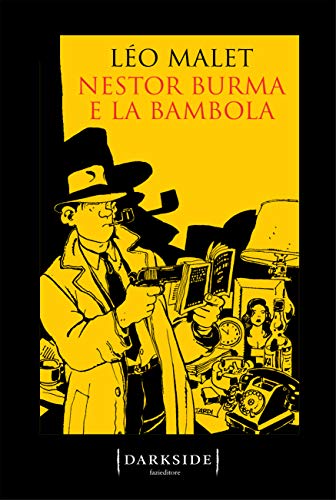
Part of Series
Tempi duri per Nestor le casse dell’Agenzia Fiat Lux sono drammaticamente vuote e la pioggia primaverile rende Parigi sempre più cupa. Così, fiutata la possibilità di un mistero, il detective privato si reca di nascosto presso un’isolata villa di Boulogne, dove sarà l’involontario e sbigottito testimone di una strage, messa in atto da un losco individuo dal volto deturpato. La vittima, tale Mauffat, sembra essere a sua volta un personaggio poco un ex medico radiato dall’ordine, che custodiva nella propria cassaforte mazzette di banconote e bottiglie di benzina… A complicare le cose si aggiunge il fatto che Mauffat venga anche considerato il responsabile della morte della giovanissima Yolande Bonamy, deceduta in seguito a un aborto mal ad accusare l’ex medico sono i nonni della ragazza, che, in mancanza di prove concrete, affideranno al protagonista il compito di incastrare l’assassino rimasto impunito. Ma come fare, ora che l’assassino stesso è stato a sua volta brutalmente assassinato? Ancora una volta toccherà a Nestor Burma risolvere l’intrigo, muovendosi tra sicari prezzolati, locali a luci rosse, chanteuses decadute e “bambole”, reali o sognate… E sarà proprio una “bambola” la chiave per decifrare il mistero. Nestor Burma torna in libreria, pronto a riconquistare i lettori con l’irriverenza e l’umanità che lo contraddistinguono, espresse al loro meglio in questa nuova avventura, finora inedita in Italia. «Se non ci fossero i soliti, pigri confronti con cui vedersela – un giallista migliore di Simenon, l’adattamento francese di Chandler – gusteremmo in pieno ogni pubblicazione di Léo Malet come l’irrompere dell’anticonformismo, schietto e irritante, su una scena dominata dai canoni della correttezza. A maggior ragione nel caso di un inedito». Roberto Iasoni, «Corriere della sera»
Author

Léo Malet est né à Montpellier en 1909. Attiré par l'écriture et l'anarchie, il décide à l'âge de 16 ans de « monter » à Paris, ou pour survivre il effectue une multitude de petits métiers. En 1930, il fait la connaissance d'André Breton et découvre le surréalisme, dont il devient un familier. Après la guerre, Léo Malet rencontre Louis Chavance qui lui suggère d'écrire des romans policiers, un genre encore inexistant en France. Malet produit alors d'alertes contrefaçons de Hard boiled américains qu'il signe des pseudonymes de Frank Harding ou Léo Latimer. En 1943, il publie sous son véritable nom, 120 rue de la gare, un roman policier très français qui met en scène pour la première fois l'illustre Nestor Burma. C'est en 1953, lors d'une promenade, que Léo Malet aura l'idée de faire de son privé un nouveau « piéton de Paris ». Le soleil naît derrière le Louvre inaugure la série des Nouveaux Mystères de Paris, un an après. Chroniques réalistes de la vie des quartiers parisiens, Les Nouveaux Mystères de Paris donnent définitivement à son personnage ses lettres de noblesse. Avec 55 titres (dont 29 consacrés à Nestor Burma), Léo Malet a bien mérité des Lettres françaises. Il est mort en 1996. (source: Pocket.fr) +++++++++++++++++++++++++++ Leo Malet was born in Montpellier. He had little formal education and began work as a cabaret singer at "La Vache Enragee" in Montmartre, Paris in 1925. In the 1930s, he was closely aligned with the Surrealists, and was close friends with André Breton, René Magritte and Yves Tanguy, amongst others. During this time, he published several volumes of poetry. He died in Châtillon, a little town just south of Paris where he had lived for most of his life, four days before his 87th birthday. Though having dabbled in many genres, he is most famous for Nestor Burma, the anti-hero of Les Nouveaux Mystères de Paris. Burma, a cynical private detective, is an astute speaker of argot (French slang), an ex-Anarchist, a serial monogamist and an inveterate pipe smoker. Of the 33 novels detailing his adventures, eighteen take place in a sole arrondissement of Paris, in a sub-series of his exploits which Malet dubbed the "New Mysteries of Paris" quoting Eugene Sue's seminal "feuilleton"; though he never completed the full 20 arrondissements as he originally planned. Apart from the novels, five short stories were also published, bringing the total of Burma's adventures to 38. The comic artist Jacques Tardi adapted some of his books much to the author's approval claiming that he was the sole person to have visually understood his books; Tardi also provided cover illustrations for the Fleuve Noir editions of the novels, released from the 1980s onward.

